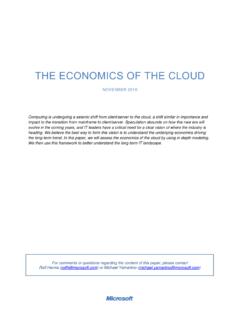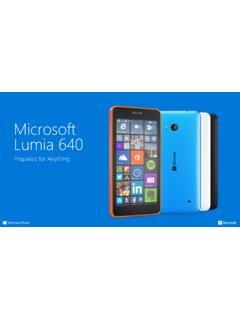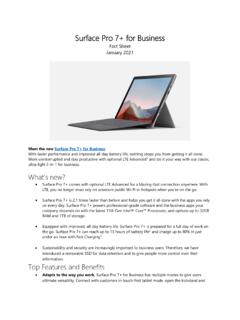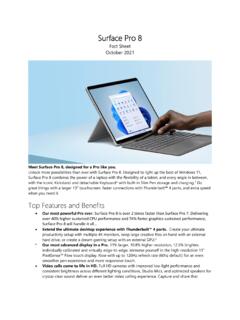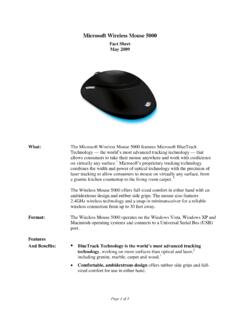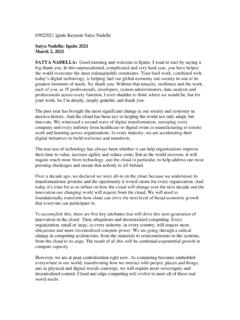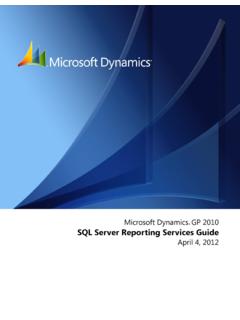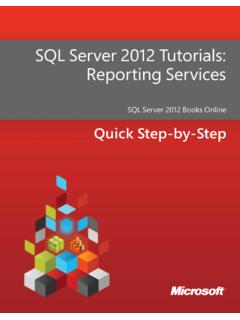Transcription of Microsoft SQL Server 2016: An Initial Assessment
1 Publication Date: 10 Jun 2016 | Product code: IT0014-003125 Tony Baer Microsoft SQL Server 2016: An Initial Assessment Renewed focus on security and extensibility This is a licensed reprint from Ovum Research. Additional reports referenced in the Appendix available on the Ovum Knowledge Center Microsoft SQL Server 2016: An Initial Assessment Ovum. All rights reserved. Unauthorized reproduction prohibited. Page 2 Summary Catalyst Microsoft recently announced that SQL Server 2016 would hit final release on June 1. Highlights of the release are in several areas: advanced analytics leveraging PolyBase and in-database R support; expanded in-memory options; a new phased migration option to the cloud; and several security features that make data protection more granular. And Microsoft has extended SQL Server 's reporting services utility to support the mobile clients that enterprises are expecting as part of the BI stack.
2 Ovum view Given that there have been four release candidate offerings, there has been little mystery as to the ultimate makeup of the forthcoming product. With the important exceptions of the Stretch Database capability, which allows portions of a database to migrate to the Azure cloud, most of the enhancements in SQL Server 2016 are supported in various forms in rival database platforms. The significance instead is Microsoft 's core competency to popularize and commoditize technologies that debuted elsewhere through simplified visual tooling, aggressive price points, and compatibility with tooling that already reaches a large professional skills base. That continues in the current release, which brings important capabilities to Windows: expanded in-memory computing, pushdown in-database analytics, more granular and dynamic data security, hybrid cloud support, and housekeeping features aimed at productivity and compliance.
3 The teaser announcement of a planned Linux release is still the stuff of product roadmap. Key messages SQL Server 2016 represents a solid update that keeps current with industry trends with in-memory computing, in-database analytics, native mobile BI reporting clients, and more granular security. The Stretch Database capability represents a breakthrough for phasing migration of individual databases to the cloud, but as first-generation technology, is feature-incomplete. New security options such as Always Encrypted and row-based access are additive, not replacements for existing data protection and access control practices. Recommendations Recommendations for enterprises Microsoft SQL Server 2016 provides a solid update for OLTP and mixed OLTP/analytic workloads that, for the most part, keep current with scaling, in-memory processing, and security features in the database market.
4 It also provides a logical extension of reporting services to support native clients on iOS, Android, and Windows Phone. The exception is the stretch capability, which breaks new ground in providing the ability to migrate parts of a database to the cloud, eliminating the need for all-or-nothing decisions. That capability is potentially very useful for piecemeal cloud migrations or hybrid Microsoft SQL Server 2016: An Initial Assessment Ovum. All rights reserved. Unauthorized reproduction prohibited. Page 3 scenarios, but for now the uses will be limited to archival (nonchanging) data, but keep your ear to the ground on this one because we expect Microsoft will target early enhancements. Other highlights include lifting a number of limitations from the Hekaton in-memory technology ( , in capacity and ability to accept JSON data), opening it up to a wider range of use cases involving hot spots with frequently updated tables or ETL staging servers.
5 In-database R analytics brings SQL Server to parity with rivals, meaning you can now unleash your data scientists to run programmatic analytics with the benefit of full multithreading. With the announcement of SQL Server 2016, Microsoft is boasting highly competitive TPC-E (transaction) and TPC-H (decision support) benchmarks. While we take all vendor-supplied benchmarks with a grain of salt, our takeaway is that SQL Server 2016 performance is certainly competitive. Scope Microsoft 's database business has diversified considerably over the years. For SQL relational databases, SQL Server is no longer the only game in town. Microsoft also offers a platform optimized for the Azure cloud as platform-as-a-service: Azure SQL Database. And it offers a massively parallel processing (MPP) analytic appliance that is branded Analytics Platform System (APS). The focus of this release, and this report, is on the newest refresh of the flagship platform, SQL Server 2016.
6 Extensibility is a core theme "Stretching" to the cloud SQL Server 2016 adds a clever option to "stretch" the database so some of it can be stored in the cloud on a new dedicated SQL Server Stretch Database Azure service. Note that while early prerelease versions supported Azure SQL Database, we expect that customers will prefer the full SQL Server route to ensure feature compatibility. The new feature, Stretch Database Advisor, allows selected database tables (or filtered data from a specific table) to move to the cloud based on preset rules for data archiving. In its Initial release, the stretch tables would be archived data that would be immutable. By comparison, Oracle Database 12c implements such a feature at the pluggable database level. Aimed at hybrid cloud deployments for transaction systems that keep large amounts of historical data online, the Stretch Database feature may be useful for scenarios such as phasing migration of a database from on premise to the cloud (aka "gradual cloud adoption"); and/or selectively archiving older data to the cloud while keeping current data on premise, without changing the application.
7 We like the idea of Stretch Database for cloud migration of a database for mixed transaction and analytic workloads involving current and almost-current data. However, for analytics that will rely heavily on long-term visibility ( , going back multiple years for an "active archiving" use case), Hadoop (HDInsight in the Azure cloud) would be the more economical option. The stretch capability is first generation; it does not yet support Tables that are memory-optimized; use change data tracking. Specialized data types such as timestamp, XML, spatial, or geography. Microsoft SQL Server 2016: An Initial Assessment Ovum. All rights reserved. Unauthorized reproduction prohibited. Page 4 Update or Delete functions (at this point, stretched data in the cloud must be treated as an immutable archive). Getting there will require some more complex engineering for full ACID support.
8 Automated bursting of data to the cloud. At this point, compute (and storage) capacity can be ramped up rapidly when there is a spike in activity, but that must be handled manually. Here's another feature for the wish list: For closely coupled applications (applications with direct reliance on specific SQL Server tables), it would be beneficial to have a feature that could automatically migrate applications in containers along with the stretched tables, but that would require that the limitation to historical data be lifted. Our verdict? SQL Server 2016's Stretch Database feature is a useful first step for making cloud migration seamless that we expect in future releases will become more feature-complete. Extending to mobile analytics SQL Server reporting services (SSRS) has always been one of the capabilities that differentiated SQL Server from its principal rivals; by contrast, Oracle and IBM DB2 reporting tools are la carte (included as part of separate BI suites), while Teradata does not provide native reporting tools.
9 SSRS allows SQL Server customers to avoid the need for buying la carte BI or visualization tools. SSRS has been Microsoft 's on-premise solution for building paginated reports, while Power BI has been the pure cloud-based solution for building interactive visualizations. Microsoft also offers SQL Server Analysis services (SSAS) as an optional add-on for providing multidimensional OLAP cubes for faster report generation. Outside the database, there is Excel, which can be used for generating analytic reports through its charting capabilities (for that reason, Excel has often been referred to as the world's de facto most popular BI tool). To this portfolio, SQL Server 2016 adds mobile reports that generate native reports in Android, iOS, and Windows Phone formats. SSRS mobile reports are dynamically adjusted to the footprint from tablet to smartphone form factor. This capability has come through Microsoft 's 2015 acquisition of partner Datazen Software.
10 The company developed a Server that converted SSRS and Microsoft Power BI visualizations to mobile form factors. Since the acquisition, Microsoft customers with SQL Server 2008 and newer were entitled to free downloads of the Server . SQL Server 2016 integrated that capability, eliminating the need for a separate mobile report Server . Obviously, Microsoft is not the first to add mobile BI reporting those capabilities have become widely available with many third-party BI, reporting , and visualization tools. But adding it to the core database allows Microsoft customers to get basic reporting capabilities now on mobile without additional third-party tool cost or architectural complexity. Also introduced is an upgraded HTML5-based Web Report Manager portal that adds support for the new mobile report-generation capability (mobile and desktop reports can be accessed from the same portal). A new focus on advanced analytics In-database R analytics Although Microsoft does offer a separate SKU for analytics, one of the themes of the 2016 release is extending the envelope for analytics for mixed workload environments.

